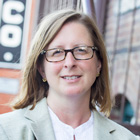All Together Now:
Public Art & Public History
To call yourself a generalist is, generally, not a good thing. To be a specialist is where it’s at—at least in terms of rising to the top of your field. But, I like a little bit of (almost) everything, and that’s probably why I fell for art history many years ago, but also why my Ph.D. is in the Humanities with a focus on the Humanities & Culture.
The overarching occupation of art history is the study and interpretation of works of art, as well as the time, place, and people who produced them. Books such as Art for Hartford, A Capital City and Its Public Art, The Public Artscape of New Haven: Themes in the Creation of a City Image, and Art of the Amistad and the Portrait of Cinqué are examples of this pursuit. But, even when I am writing “straight” history such as my A History Lover’s Guide to Alexandria and South Fairfax County, Historic Virginia: A Tour of More Than 75 of the State’s Top National Landmarks or A Guide to Thomas Jefferson’s Virginia books, I begin projects and find inspiration–and source material–in the stories embedded in objects, places, and people.
Identifying and teasing out these stories is the method to the madness, and is very much a humanities pursuit that crosses the boundaries between public art and public history.
Placemaking is the word that brings much of this work together. Many things are wrapped up in creating a sense of place, including historic sites and contemporary art, parks and landscapes, and public spaces such as museums, libraries, farmers’ markets, community gardens, and walking paths and trails. In placemaking, the core idea is to utilize history in conjunction with contemporary needs to design exhibits, programs, and works of public art and history that reflect on, and perhaps move forward, the meanings we attach to a particular place. In other words, placemaking utilizes public art and public history as tools for community and cultural development.
What is it like to do this kind of work? When undertaking a new project, research in libraries and archives is only half the fun (and it is fun!). The other half is surely visiting those objects and places involved with your project and seeing firsthand how they work and what meaning is created about them, and for them. What do people think and feel about their places, and why?
One of my earliest experiences doing this was as a Student Conservation Association (SCA) intern at Mesa Verde National Park the year after I graduated from college. I can still remember the different people I met while there, in that rustic pre-Internet era—park rangers and archaeologists, an artist and her husband, as well as the volunteers who accompanied a group of us on a nighttime hike to listen for owls.
We were all there together, a hodgepodge of humanity, drawn to the place itself, where we breathed in the scent of juniper berries and pine needles on the flat, green mesas, and cared for the prehistoric past left behind in kivas and cliff dwellings. This trip was the first time I visited a Walmart (in Cortez, Colorado) and the first time I went to “Indian Country,” where I ate frybread. All of these things—whether high culture or low, whether ancient or new—coalesce into a unique sense of place.
The work is challenging but gratifying, existing somewhere between the walls of academia, the efforts of not-for-profit organizations and municipalities serving their constituents, and the work of artists and local historians who follow their vision and passion to change society through the act of creating and sharing history and art. To share what I’ve learned, I research, write, work in museums and historic sites, write grants, present at conferences, and publish across platforms, from academic journals to general interest books in print, to websites and crowdsourcing platforms such as Wiki Loves Monuments, Clio, and the Public Art Archive.
I am also proud to have been a part of the following national and international programs:
Student Conservation Association, Mesa Verde National Park, 1995

Fulbright Scholar Program, Swaziland National Museum, 2008-2009

Ambassador’s Fund for Cultural Preservation, Swaziland National Museum, 2010

Peace Corps VSPP, Matsapha Town Council, Eswatini, 2025-2026

Finally, I serve on several boards in leadership positions, including the Cumberland County Regional Library System (President), the Amelia Givin Free Public Library (Vice President), and Craighead House (Chair of the Archives & Museum Committee). I am also a volunteer at the Appalachian Trail Museum in Pine Grove Furnace State Park. For more details on my professional background, please visit my LinkedIn page or view my résumé below.
